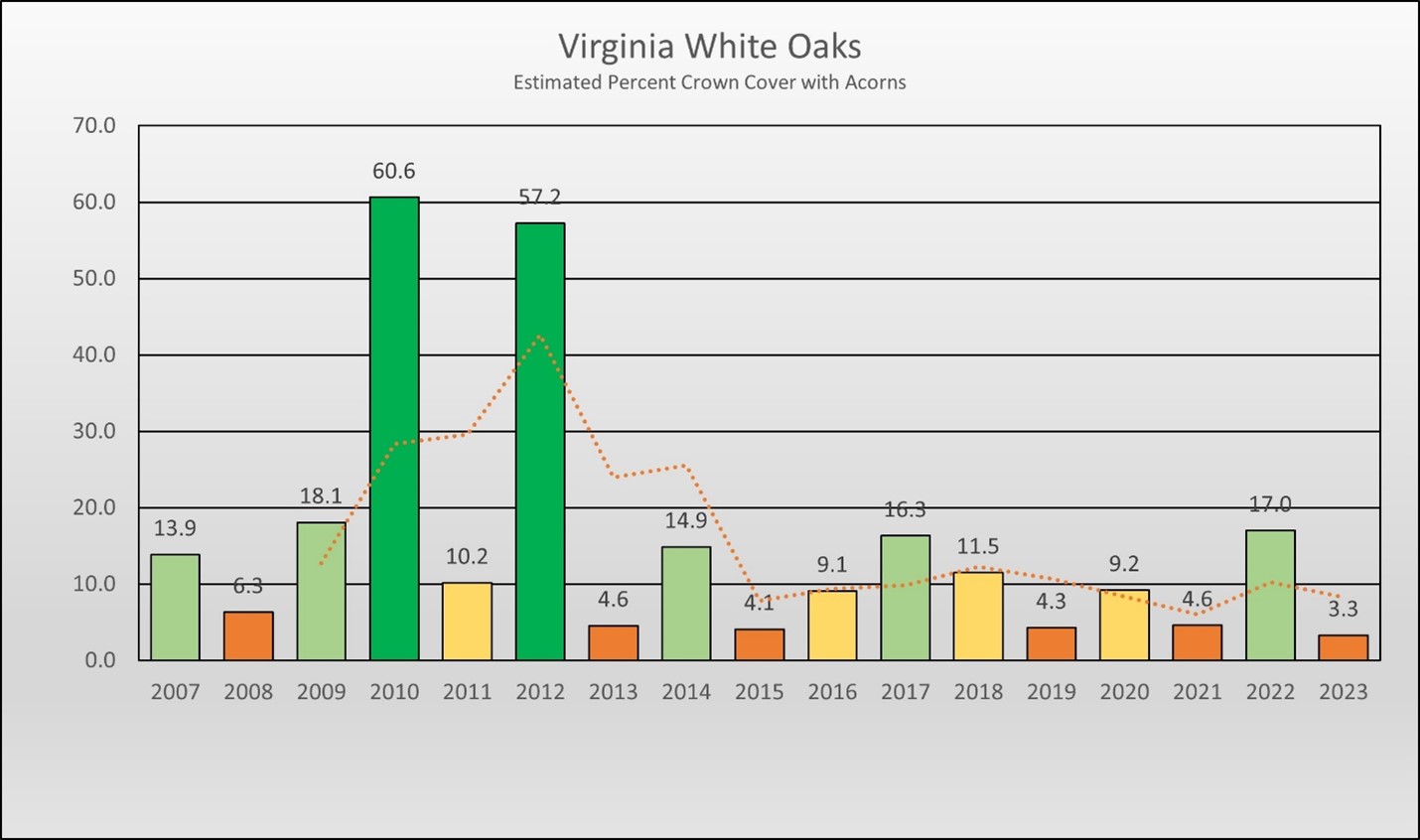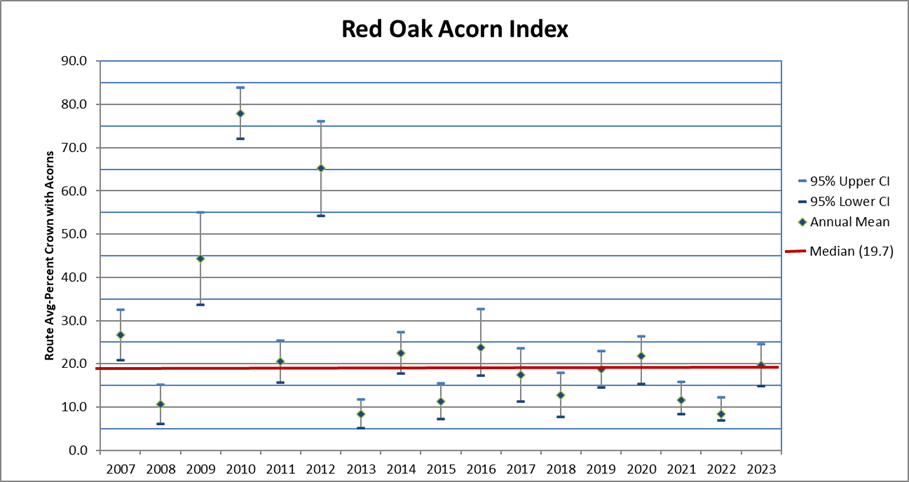By Katie Martin/DWR
Photos by Meghan Marchetti/DWR
Acorn production across the state in 2023 can be categorized overall as extremely poor for white oak and average to above average for red oak species (see graphs below). Based on the annual hard mast survey, white oak routes came in at an all-time low since survey data has been recorded in this manner (2007). Conversely, red oaks surveyed right at the long-term median, breaking a two-year low. White oak was generally poor (or nonexistent) across all sites and elevations this year with very limited pockets of average production, found primarily in the north piedmont region.
The lack of white oak acorn production was not unexpected after the above-average year of production in 2022. Interestingly, when viewing hard mast data from a regional perspective, white oak production in more northern states (Pennsylvania, New Hampshire, Vermont) has been rated above average to excellent this year. Red oak production was average or above average in all areas except for the southern Piedmont and Tidewater regions (which both fell well below the long-term average). While red oak acorns are not generally preferred by many wildlife species due to their tannin content (and size), in years of poor white oak production, these acorns will often be readily consumed, especially later in the season.
As with all years, acorn production is highly variable and very site dependent. Many routes had areas of “bumper” mast production even if their overall site average was below average. This variability is due to many reasons (weather, insects, tree species), but for some of our survey sites we are probably approaching the biological end of production due to tree age. Unfortunately, finding “new” stands of mature oak in the 50- to 70-year age range is becoming more and more difficult due to aging forests and lack of sufficient regeneration. Replacing aging trees/survey sites could be quite a challenge moving forward.
The annual hard mast survey has been an ongoing effort between the Virginia Department of Wildlife Resources (DWR) and many partner agencies for many years. Many of the mountain survey sites have been in place since the 1950s. In 2023, staff from DWR, the U.S. Forest Service, U.S. Fish and Wildlife Service, the Virginia Department of Conservation and Recreation (DWR)/Virginia State Parks, Virginia Department of Forestry (DOF), U.S. Department of Defense/Department of Military Affairs, National Park Service, and Smithsonian Conservation Biology Institute surveyed 33 hard mast production sites across Virginia. Sites are located across all regions of the state, although a majority are currently found in the mountains. Continued efforts are being made to add sites to the Northern Piedmont and Tidewater areas.
Production by Region: White Oak


- Mountains: White oak production across most of the mountain region (19 survey sites) was almost nonexistent. Many routes averaged zero trees with any acorn production across the entire route (40+ trees surveyed per route). Minimal production was noted in the southern mountain region with the highest production found in the far south mountain region in a route that spans across both Virginia and Kentucky. Oak regeneration is a serious conservation issue in all of these areas and ongoing habitat management efforts have been underway by DWR and partner agencies to enhance areas with significant oak decline.
- Piedmont: White oak production across the Piedmont (11 sites) was more variable than the mountain region, with the North Piedmont recording the highest averages across all sites sampled in 2023. The two most “northern” routes surveyed in the state both came in above the long-term average in 2023. Conversely, they were some of the lowest routes surveyed in 2022. The central and southern Piedmont area had minimal production although single trees in some routes were noted at 80-100% full! If you can find one of those “bumper” trees you may be in for a treat of wildlife activity.
- Tidewater: The Tidewater area has our lowest sample size with 3 sites. In 2023, all three sites noted only 0-1% total white oak production. This is about on par with past survey lows for this area and follows the boom-and-bust cycle of white oaks. With low sample numbers it’s hard to make any solid conclusions about acorn production in this area but reports of excellent soft mast production were noted throughout this area all summer.
Production by Region: Red Oak


- Mountains: Red oak production was average to above average across the mountain region with pockets of average production, with the best production noted in the northern mountain routes. Routes from each mountain region (north, central, and southern) had over 30% production across a route, which is well above the long-term survey average (19.7%).
- Piedmont: Red oak production was above the long-term median in two out of the three Piedmont zones surveyed, with only the southern Piedmont falling well short of the average. Production across all sites trended slightly higher than that found in the mountain region with several routes averaging above 40% (47% and 62%). The southern Piedmont recorded some of the highest red oak production in 2022 across the state, thus the below average production in 2023 is not unexpected.
- Tidewater: The Tidewater region averaged below the long-term median across all three sites and trended slightly lower than reports from 2022. Red oak production in this region has tended to trend below that of the other regions since routes were initiated here. While overall production was poor, there were several above average trees noted in each route.
What does all of this mean for hunters and wildlife viewers for the fall of 2023? Due to the lack of acorns across most of the state, many wildlife species will likely be more mobile throughout the fall in search of alternative food sources. This can make them more visible to both hunters and other outdoor recreationists in open fields, food plots, and other early successional habitats. Secondary hard mast sources such as hickory, beech, and chestnuts (primarily Chinese chestnut) were in abundance across much of the state as were soft mast species such as blackberries, blueberries, pokeberry, wild grapes, paw-paws, persimmons, dogwood and black gum fruits. This means many wildlife species should be fairly active throughout the fall in search of these food resources but will likely limit movements later in the winter to conserve energy as available food sources dwindle.
Katie Martin is DWR’s deer/bear/turkey biologist.


